Fixing QTE
Quick Time Events have problems. They aren't generally well regarded, for some valid reasons, yet they fill a niche that nothing else does properly. So, instead of complaining about them is it possible to fix them?

I don't like Quick Time Events (QTE) but I do understand why games keep including them, why some games feel like they need them. In spite of how little I like them they do fill a very needed role in games, and so my spite is pointless unless there is a better replacement for them.
The need for QTE stems from a game not having a sufficiently robust mechanical vocabulary to allow the player to do what the game wants the player character to do. Mario games don't need to have QTE sections that involve jumping over obstacles because the game's controls and engine are all about jumping over stuff, and Doom doesn't need QTEs for running around and shooting because the game gives the player a large set of mechanics that allow them to do that on their own. A game like Until Dawn though doesn't have a robust set of running/climbing/fighting/making out mechanics though, and QTE is great for when you want the player character to do something really cool and specific that the game doesn't naturally let the player do. Thus, Until Dawn has a lot of QTE.

For example Until Dawn doesn't have a complex hand gesture system or even a fully committed "High Five" button, so High Fives get handled with QTEs.
Is the solution to just have a more robust mechanical vocabulary that lets the player do anything? No, or at least not in the case of Until Dawn. While perhaps there is some theoretical control scheme that lets the player act out all the different actions the game wants a player character to perform - I doubt it, but even if - that control scheme would be crazy complicated and more importantly would draw focus away from the true heart of the game.
Until Dawn is a very story centered game and I think it is fair to say that in general games that use QTE tend to be more story focused then games that don't, or are at least less mechanically focused. In Until Dawn you spend more time watching characters and seeing the results of your choices/failures than you do inputting commands. That isn't a failing, the game is less concerned about your ability to control the character's physical bodies then it is about letting you explore their head space/choices.
Your actions can help bring out the good/bad in these characters, you can explore who they are as people and what their psychological strengths and limits are. That is what the game is interested in. Spending the time to train the player in a robust control scheme for letting them run, jump, climb, fight, shoot, dodge, make-out and what-have-you would be a waste of time. It would be at best a distraction from what the game actually cares about. The game wouldn't be better if it added another 10-20 hours into the middle of it that is nothing but training the player in a system of robust platforming and cover shooter mechanics that could replace all the actions the QTEs take up.
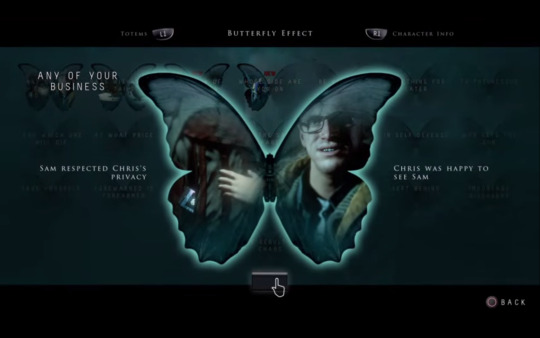
Especially since the game is all about being played multiple times with different choices and any tutorials the game has would have to be gone through many times. Games that are about replayability have to be very careful with their tutorials because players will be seeing it a lot and tutorials get old fast the first time you see them. Given that, a mechanically complex control scheme that requires a lot of tutorials would be a bad idea.
Yet the stories the game wants to tell involves a diverse set of actions and it want to let the player fail at doing those things in the interest of creating suspense and tension (admirable goals). As such the game turns to QTEs for a solution. They aren't great, but they are something. It is easy to frame QTEs as a yes/no situation but in truth the question is "if not QTEs then what"? Instead of just complaining about them let’s see if we can fix them - a bit.
Until Dawn has a couple kinds of QTE, the most used are: the classic quickly-press-the-button-we-tell-you-to kind, the quickly-pick-an-option kind (where you select from multiple options), and one that is partly a shooter mini game where you have to line up a recticle with the target you want to shoot.
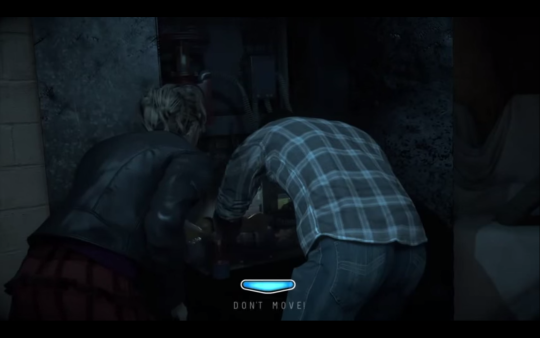
Until Dawn also has a don't-move QTE that I really like. It's kinda like the opposite of a QTE as the goal is to not do anything, even move. I can see it being gimmicky if over used, but it is great for a horror game and Until Dawn uses it well.
The quickly-pick-an-option QTE is generally pretty great. You are told to pick between 2 things and then a timer starts ticking down and you have to pick. Take the short-cut or the safer path? Save yourself or try to save someone else? Insult someone or comfort them? Most people don't even consider it a QTE, and I only really only consider it one on a technicality as it is still is a press-button-before-timer-runs-out kind of thing. It is less about reaction time then it is about forcing a player to pick a response within a reasonable amount of time. To be able to respond quickly/correctly the player needs to understand what is going on in the scene, they need to have a firm understanding of the context of this choice in order to make it. The point of it is choice, the timer is just there to add pressure to that choice. This is a great mechanic, this is a good form of QTE and nothing need to be changed about it.
The quickly-press-the-button-we-tell-you-to form of QTE is all about reaction time and is the most common form QTE. It is also the most problematic form. My biggest problem with this kind of QTE is that when you know one is coming you don't want to pay attention to what is happening on screen. The pretty graphics and intense action on the screen is a distraction, all you care about is the controller button that pops up telling you how to solve whatever problem is happening. After I complete a QTE section I couldn't tell you what happened during it, in fact I actively try to ignore what is happening on screen so that I can succeed at whatever I'm supposed to be doing. These QTEs aren't pulling players into the game's world rather it is pushing them out by forcing them to focus on something other than the player character. How do we make it so that these QTEs pull players into the game? My solution is to make everything a choice.
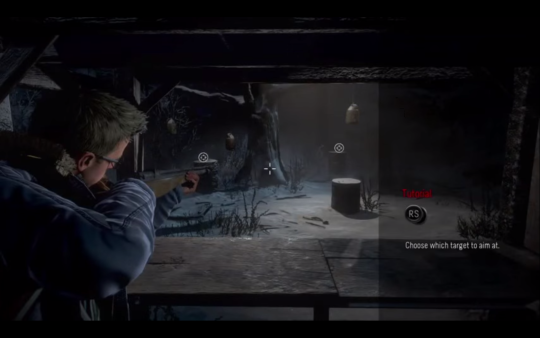
In the shooting version of QTE Until Dawn has the goal isn't to just line up the target recticle with the only target and push a button, often the game will give you multiple targets you can shoot at. Some of those things are good to shoot, some are bad. You aren't just reacting to button prompts on the screen you are looking at the scene and choosing what you want to shoot. Do you want to shoot the monster jumping at you or the beer bottle to the left of them? Given a moment to think this is an obvious choice but as the game gives you so little time during these reaction based QTEs it becomes a challenge to not just react but to process what is happening and then react.
By making the QTE a choice the player has to pay attention to what is going with the player character, this will hold true even if the choices are obvious because of the added pressure of the timer. For example, instead of having the QTE be "Press X to catch falling person" the game could give you multiple prompts at once and asks you how to respond to a falling person: X for catch falling person, Square for Grab at the air to their right, Triangle for grab beer bottle to their left. We can indicate these choices by our placement of the prompts: over the hand of the falling person, in the air to their right, over a beer bottle on their left. How you should respond is obvious, grab the falling person, but you are on a timer and have to respond quickly and correctly. By simply giving the player bad choices they have to avoid we force the player to have to pay attention to what is going on in the scene, we draw them into what is happening.
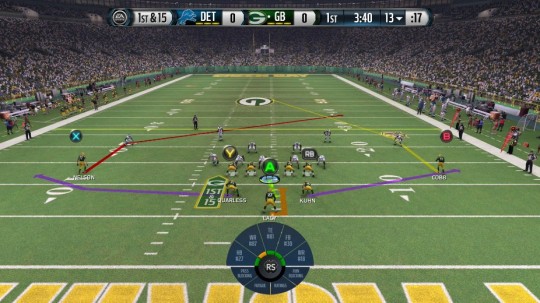
This model for QTEs is based off of how passing plays work American Football games. A lot of things are going on at once and you choose who to pass to with a single button press. It allows for timed decisions that can relate to a complicated series of actions to be handled with a single button press. It requites a great deal of attention to pull off regardless of how mechanically easy it is to do.
We can easily apply this model to all the reaction based QTEs. Climbing a wall QTE? Have the player press a button that corresponds to the stone that isn't lose and about to fall. Running through the woods? Have the player press buttons to pick out where they put their feet (avoid holes, roots, or have them pick which rocks in a stream they want to step on). It is a mechanically simple system that is very flexible that draws the player into the game scene and rewards them for understanding what is going on.
QTEs have problems, but they are necessary for certain kinds of games. Luckily the problems they have can be fixed, or at least thoroughly mitigated. So, I'm going to stop bashing QTEs on principle and start trying to talk up solutions to some of the more obvious problems they have because - like it or not - they are here to stay.
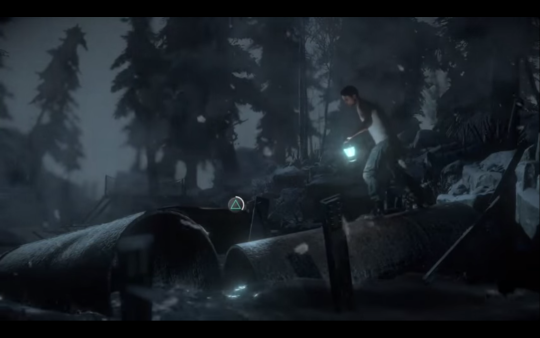
Also games that use QTEs are the easiest in the world to create difficulty levels for, you just have to give the player more time to input the command (maybe slow the world down to make that time). Yet, games with QTEs routinely don't do this. Why? It is so easy and helpful for players. Just do it. Seriously.
Read more about:
BlogsAbout the Author(s)
You May Also Like













